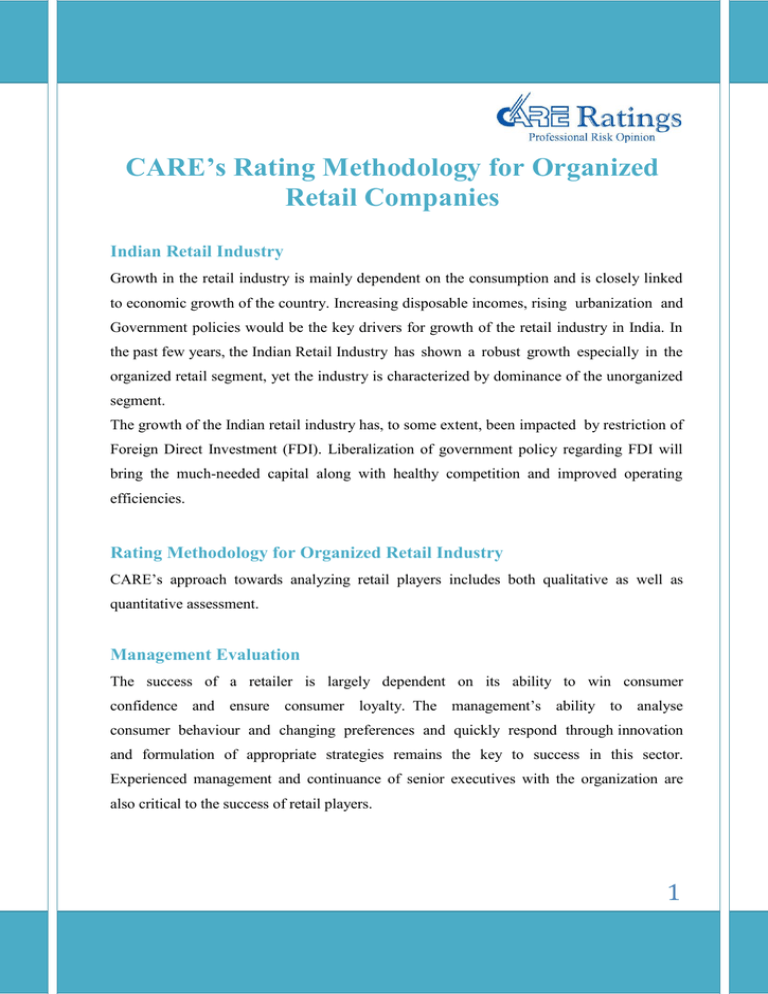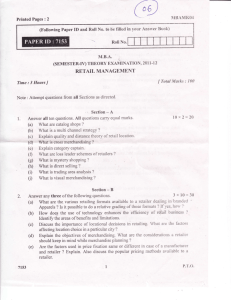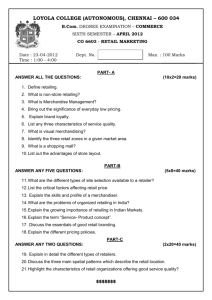CARE’s Rating Methodology for Organized Retail Companies Indian Retail Industry
advertisement

CARE’s Rating Methodology for Organized Retail Companies Indian Retail Industry Growth in the retail industry is mainly dependent on the consumption and is closely linked to economic growth of the country. Increasing disposable incomes, rising urbanization and Government policies would be the key drivers for growth of the retail industry in India. In the past few years, the Indian Retail Industry has shown a robust growth especially in the organized retail segment, yet the industry is characterized by dominance of the unorganized segment. The growth of the Indian retail industry has, to some extent, been impacted by restriction of Foreign Direct Investment (FDI). Liberalization of government policy regarding FDI will bring the much-needed capital along with healthy competition and improved operating efficiencies. Rating Methodology for Organized Retail Industry CARE’s approach towards analyzing retail players includes both qualitative as well as quantitative assessment. Management Evaluation The success of a retailer is largely dependent on its ability to win consumer confidence and ensure consumer loyalty. The management’s ability to analyse consumer behaviour and changing preferences and quickly respond through innovation and formulation of appropriate strategies remains the key to success in this sector. Experienced management and continuance of senior executives with the organization are also critical to the success of retail players. 1 Industry Analysis CARE’s analysis of the industry risk focuses on the current industry scenario, prospects of the industry and the competitive factors affecting it. Demand-supply factors, regulatory policies and investment plans of the major retailers are analyzed. CARE also takes into account economy-wide factors which have a bearing on the retailing industry. Business segment Retail business can be broadly classified into ‘Value Retailing’ and ‘Life style Retailing’. ‘Value Retailing’ caters to essential needs of the consumer and is relatively immune to economic downturns as against ‘Life-style Retailing’. Value Retailing is a highvolume but low-margin business. In contrast, Life-style Retailing is a high- margin and low-volume business and also fosters higher customer loyalty with relatively low substitutes. Further, higher-margin private label portfolio across segments contributes significantly to the profitability of the players in this segment. Nevertheless, the Lifestyle retailer needs to have a judicious mix of private labels so as not to dilute the offerings as regards other brands. Analysis of a retailer’s business segment, and the mix adopted by the player and its cash flow impact assume prime importance in a rating exercise. Cash flows of a Value retailer tends to be relatively more stable while those of Life-style retailer are relatively seasonal in nature, leading to impact on working capital requirements. Cash flow volatility is particularly important in this sector given the significant fixed nature of operating cost. Market Position, Size and Operating efficiency CARE analyses the market position of the player, its market share, geographical presence and ability to cater to local tastes by right product mix and pricing and the level of competition in the business segment. Large scale of operations results in economies of scale and provides a competitive advantage with respect to pricing. Size not only boosts the bargaining power of a retailer while accessing quality real estate or ‘anchor tenant’ status but also provides it with better bargaining power with its suppliers. Further, operating parameters like rate of rise in sales per square feet, footfalls and conversion rate, average selling price, average transaction size, proportion of sales under customer loyalty program 2 and shrinkage are some of the key indicators for assessing the operating efficiency of retail companies. Ability of the promoters to infuse/raise funds Retailers require significant investments in fixed assets in the form of retail outlets and distribution networks. Additionally, the players also require funds for refurbishment & relocation and meeting working capital needs on a continuous basis. Thus, the strategic importance of the retail venture to the promoters and their ability and willingness to infuse funds in timely manner is a key rating criterion. Group Support CARE evaluates the operating synergies of the rated company with group in terms of the sourcing, logistics & distribution system etc. CARE believes that retail companies with access to real estate through group holdings enjoy an advantage over others. Further, presence of a strong group and parentage would result in enhanced financial flexibility. Access to real estate One of the major input costs for a retailer is lease rentals/land acquisition cost. Retailers with access to low-cost, quality real estate enjoy a considerable competitive advantage, both in terms of saving of major cost components as also ability to expand more quickly. Timely availability of real estate facilities as envisaged is critical as it may have an impact on cash flows. CARE also analyses rental cost to total sales of the company vis-à-vis other players. Store-wise analysis CARE analyses the store-wise data in terms of same-store sales, proportion of profitable stores, average time to breakeven, region-wise stores and type of operating model (Owned, Leased, Revenue sharing, Franchise etc). Ownership of the stores ensures business continuity especially in case of strategic locations and reduces the uncertainties of renewing/re-negotiating of lease contracts. However own stores require higher initial capital cost per square feet and entail larger exit cost (compared to lease option). In case of lease or revenue-sharing contracts or franchise model, multi-year leasing contracts and 3 details regarding sharing of risk and reward are evaluated to assess its impact on future cash flows and its associated impact on the entity’s risk profile. Capital Structure and Financial Flexibility Retailers require significant funds for expanding stores network as well as for refurbishment of existing stores. CARE evaluates the capital mix used to fund these assets. Low leverage and comfortable debt coverage indicators are viewed positively and aggressive debt-funded expansion is considered adverse from a rating perspective. The company’s ability to generate sufficient internal accruals and/or raise timely equity, if required, to meet its capital expenditure is one of the key rating factors. Also strong parentage would result in enhanced financial flexibility. CARE also analyses Off-balance sheet exposures of the company and adjustments are made to the accounts, wherever necessary. Working capital management As retail business is highly working capital intensive in nature mainly on account of high level of inventory required to be maintained to ensure ready availability of stock, inventory management assumes importance. Inventory management encompasses ability to determine and maintain optimal inventory level, right offerings and minimize shrinkage. Lifestyle retailers need even more working capital funds due to the big-ticket items held as stock. Although the ‘Private label portfolio’ and ‘outright model’ have higher margins vis-à-vis other business models, they entail higher working capital requirements as the risk of unsold inventory is borne by the retailer. Besides, quality of inventory in terms of its aging schedule in the context of changing needs of the consumers is analysed, especially in case of perishable products. CARE also analyses the extent of dependence on suppliers and ability of the retailer to negotiate with suppliers or procure directly eliminating the middlemen’s margin. Further, CARE evaluates the effectiveness of the supply chain, as the same has a direct bearing on operational efficiencies and optimizing the working capital requirement. 4 Supply Chain/ IT Infrastructure CARE evaluates the supply chain infrastructure in terms of the integrated distribution, warehouse & transportation systems, effective store level infrastructure like replenishment systems & reorder levels, as these factors have a direct bearing on the operational efficiencies and hence the profitability of a retailer. Operating Cash flows and Debt protection measures Cash flow analysis forms an important part of credit rating exercise. The ability of the company to generate healthy positive operating cash flows is very critical. Cash accruals vis-à-vis debt levels and other debt protection measures like interest coverage ratio, Debt Service coverage and Cash Debt Service coverage ratio are examined. Further, analysis of sensitivity of these factors to adverse change in assumptions is also carried out. Conclusion The rating outcome is ultimately an assessment of the fundamentals and the probabilities of change in the fundamentals. CARE analyses each of the above factors to arrive at the overall assessment of credit quality of the Issuer. 5 HEAD OFFICE - MUMBAI CREDIT ANALYSIS & RESEARCH LTD 4th Floor, Godrej Coliseum, Somaiya Hospital Road, Off Eastern Express Highway, Sion (East), Mumbai - 400 022. Tel: +91-022- 6754 3456 email:care@careratings.com Website:www.careratings.com Regional Offices Branch Offices Unit No. O-509/C, Spencer Plaza, 5th Floor, No. 769, Anna Salai, Chennai 600 002 Tel: (044) 2849 7812/2849 0811 401, Ashoka Scintilla 3-6-520, Himayat Nagar Hyderabad - 500 029 Tel.: (040) – 40102030/31, 91600 04563 3rd floor, B-47, Inner Circle, Near Plaza Cinema, Connaught Place, New Delhi - 110 001. Tel: +91- 011- 2331 8701/ 2371 6199 Cell: 98117 45677 Unit No. 8, I floor, Commander's Place No. 6, Raja Ram Mohan Roy Road, Richmond Circle, Bangalore - 560 025. Tel.: (080) - 2211 7140/41, 9886024430 3rd Floor, Prasad Chambers (Shagun Mall Building), 10A, Shakespeare Sarani, Kolkata - 700 071 Tel: (033)- 2283 1800/ 1803/ 2280 8472 32 TITANIUM Prahaladnagar Corporate Road, Satellite, Ahmedabad - 380 015. Tel.: (079) 4026 5656 6 Disclaimer CARE’s ratings are opinions on credit quality and are not recommendations to sanction, renew, disburse or recall the concerned bank facilities or to buy, sell or hold any security. CARE has based its ratings on information obtained from sources believed by it to be accurate and reliable. CARE does not, however, guarantee the accuracy, adequacy or completeness of any information and is not responsible for any errors or omissions or for the results obtained from the use of such information. Most entities whose bank facilities/instruments are rated by CARE have paid a credit rating fee, based on the amount and type of bank facilities/instruments. 7








